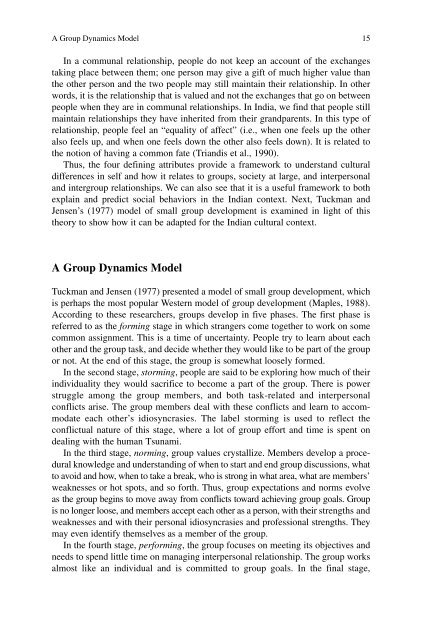Spirituality and Indian Psychology: Lessons from ... - Mandhata Global
Spirituality and Indian Psychology: Lessons from ... - Mandhata Global
Spirituality and Indian Psychology: Lessons from ... - Mandhata Global
Create successful ePaper yourself
Turn your PDF publications into a flip-book with our unique Google optimized e-Paper software.
A Group Dynamics Model<br />
In a communal relationship, people do not keep an account of the exchanges<br />
taking place between them; one person may give a gift of much higher value than<br />
the other person <strong>and</strong> the two people may still maintain their relationship. In other<br />
words, it is the relationship that is valued <strong>and</strong> not the exchanges that go on between<br />
people when they are in communal relationships. In India, we find that people still<br />
maintain relationships they have inherited <strong>from</strong> their gr<strong>and</strong>parents. In this type of<br />
relationship, people feel an “equality of affect” (i.e., when one feels up the other<br />
also feels up, <strong>and</strong> when one feels down the other also feels down). It is related to<br />
the notion of having a common fate (Tri<strong>and</strong>is et al., 1990).<br />
Thus, the four defining attributes provide a framework to underst<strong>and</strong> cultural<br />
differences in self <strong>and</strong> how it relates to groups, society at large, <strong>and</strong> interpersonal<br />
<strong>and</strong> intergroup relationships. We can also see that it is a useful framework to both<br />
explain <strong>and</strong> predict social behaviors in the <strong>Indian</strong> context. Next, Tuckman <strong>and</strong><br />
Jensen’s (1977) model of small group development is examined in light of this<br />
theory to show how it can be adapted for the <strong>Indian</strong> cultural context.<br />
A Group Dynamics Model<br />
Tuckman <strong>and</strong> Jensen (1977) presented a model of small group development, which<br />
is perhaps the most popular Western model of group development (Maples, 1988).<br />
According to these researchers, groups develop in five phases. The first phase is<br />
referred to as the forming stage in which strangers come together to work on some<br />
common assignment. This is a time of uncertainty. People try to learn about each<br />
other <strong>and</strong> the group task, <strong>and</strong> decide whether they would like to be part of the group<br />
or not. At the end of this stage, the group is somewhat loosely formed.<br />
In the second stage, storming, people are said to be exploring how much of their<br />
individuality they would sacrifice to become a part of the group. There is power<br />
struggle among the group members, <strong>and</strong> both task-related <strong>and</strong> interpersonal<br />
conflicts arise. The group members deal with these conflicts <strong>and</strong> learn to accommodate<br />
each other’s idiosyncrasies. The label storming is used to reflect the<br />
conflictual nature of this stage, where a lot of group effort <strong>and</strong> time is spent on<br />
dealing with the human Tsunami.<br />
In the third stage, norming, group values crystallize. Members develop a procedural<br />
knowledge <strong>and</strong> underst<strong>and</strong>ing of when to start <strong>and</strong> end group discussions, what<br />
to avoid <strong>and</strong> how, when to take a break, who is strong in what area, what are members’<br />
weaknesses or hot spots, <strong>and</strong> so forth. Thus, group expectations <strong>and</strong> norms evolve<br />
as the group begins to move away <strong>from</strong> conflicts toward achieving group goals. Group<br />
is no longer loose, <strong>and</strong> members accept each other as a person, with their strengths <strong>and</strong><br />
weaknesses <strong>and</strong> with their personal idiosyncrasies <strong>and</strong> professional strengths. They<br />
may even identify themselves as a member of the group.<br />
In the fourth stage, performing, the group focuses on meeting its objectives <strong>and</strong><br />
needs to spend little time on managing interpersonal relationship. The group works<br />
almost like an individual <strong>and</strong> is committed to group goals. In the final stage,<br />
15

















